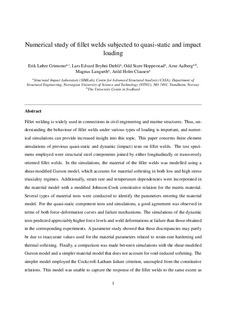| dc.contributor.author | Grimsmo, Erik Løhre | |
| dc.contributor.author | Dæhli, Lars Edvard | |
| dc.contributor.author | Hopperstad, Odd Sture | |
| dc.contributor.author | Aalberg, Arne | |
| dc.contributor.author | Langseth, Magnus | |
| dc.contributor.author | Clausen, Arild Holm | |
| dc.date.accessioned | 2017-12-21T09:43:06Z | |
| dc.date.available | 2017-12-21T09:43:06Z | |
| dc.date.created | 2017-09-20T20:24:12Z | |
| dc.date.issued | 2017 | |
| dc.identifier.citation | International Journal of Mechanical Sciences. 2017, 131-132 1092-1105. | nb_NO |
| dc.identifier.issn | 0020-7403 | |
| dc.identifier.uri | http://hdl.handle.net/11250/2473462 | |
| dc.description.abstract | Fillet welding is widely used in connections in civil engineering and marine structures. Thus, understanding the behavior of fillet welds under various types of loading is important, and numerical simulations can provide increased insight into this topic. This paper concerns finite element simulations of previous quasi-static and dynamic (impact) tests on fillet welds. The test specimens employed were structural steel components joined by either longitudinally or transversely oriented fillet welds. In the simulations, the material of the fillet welds was modeled using a shear-modified Gurson model, which accounts for material softening in both low and high stress triaxiality regimes. Additionally, strain rate and temperature dependencies were incorporated in the material model with a modified Johnson–Cook constitutive relation for the matrix material. Several types of material tests were conducted to identify the parameters entering the material model. For the quasi-static component tests and simulations, a good agreement was observed in terms of both force–deformation curves and failure mechanisms. The simulations of the dynamic tests predicted appreciably higher force levels and weld deformations at failure than those obtained in the corresponding experiments. A parameter study showed that these discrepancies may partly be due to inaccurate values used for the material parameters related to strain-rate hardening and thermal softening. Finally, a comparison was made between simulations with the shear-modified Gurson model and a simpler material model that does not account for void-induced softening. The simpler model employed the Cockcroft–Latham failure criterion, uncoupled from the constitutive relations. This model was unable to capture the response of the fillet welds to the same extent as the shear-modified Gurson model. | nb_NO |
| dc.language.iso | eng | nb_NO |
| dc.publisher | Elsevier | nb_NO |
| dc.rights | Attribution-NonCommercial-NoDerivatives 4.0 Internasjonal | * |
| dc.rights.uri | http://creativecommons.org/licenses/by-nc-nd/4.0/deed.no | * |
| dc.title | Numerical study of fillet welds subjected to quasi-static and impact loading | nb_NO |
| dc.type | Journal article | nb_NO |
| dc.type | Peer reviewed | nb_NO |
| dc.description.version | acceptedVersion | nb_NO |
| dc.source.pagenumber | 1092-1105 | nb_NO |
| dc.source.volume | 131-132 | nb_NO |
| dc.source.journal | International Journal of Mechanical Sciences | nb_NO |
| dc.identifier.doi | 10.1016/j.ijmecsci.2017.08.007 | |
| dc.identifier.cristin | 1495994 | |
| dc.relation.project | Norges forskningsråd: 237885 | nb_NO |
| dc.description.localcode | © 2017. This is the authors’ accepted and refereed manuscript to the article. Locked until 10.8.2019 due to copyright restrictions. This manuscript version is made available under the CC-BY-NC-ND 4.0 license http://creativecommons.org/licenses/by-nc-nd/4.0/ | nb_NO |
| cristin.unitcode | 194,64,45,0 | |
| cristin.unitname | Institutt for konstruksjonsteknikk | |
| cristin.ispublished | true | |
| cristin.fulltext | postprint | |
| cristin.qualitycode | 1 | |

